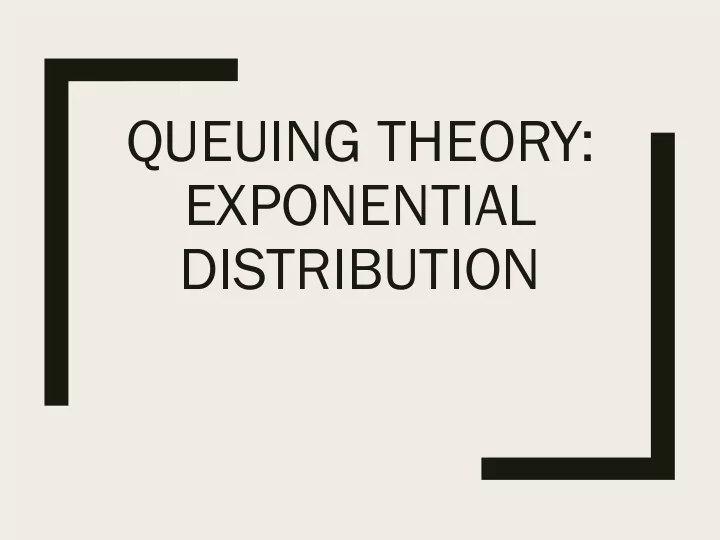

QUEUING THEORY: EXPONENTIAL DISTRIBUTION
Describing traffic ■ How can we describe traffic? Cars, pedestrian, internet, etc. ■ Also: how can we describe how traffic is processed? ■ What are some metrics? – Rate at which people arrive somewhere, e.g. “customer arrival rate per hour” – Average “downtime” – Time between people arriving ■ In Queuing Theory, we use stochastic systems to model events – Probability of an event occurring (counts) – Always over a period of time (continuous)
Random Variables ■ “Randomness can be described as unpredictable in the short term, but predictable in the long term“ -Prof. Pruim, ( pronounced “prime”) Meneely’s favorite Math Professor ■ Random Variables are a mathematical construct used to abstract away a complex system that behaves stochastically – Represent the complex physics of rolling a die with 1 variable – Flipping a coin ■ Random variables can be discrete or continuous – e.g. flipping a coin ■ Random variables are described by distributions
Distributions You Might Know ■ Most distributions have at least one parameter define the whole distribution ■ Every distribution has an input ■ Uniform distribution – Parameter: n (number of sides on the die) – Can be discrete or continuous – Fair die, e.g. f 6 (x=1) is 1/6 ■ Binomial distribution – Discrete – Parameter: p (probability of an event) – Input: number of events ■ Normal distribution – Parameters: mean, variance – Input: a continuous variable ■ Or, you can define them piecewise, e.g. unfair die
Poisson Process ■ A type of random variable that models arrival events ■ Each event is independently and identically distributed ■ In Queuing Theory, we define it along the real number line to model the series of incoming events over time ■ Poisson processes can be described by the Poisson distribution – But! We won’t be using that distribution very much, because we need another property…
Markovian Property ■ A type of stochastic system that is memoryless A 60% ■ i.e. The probability of an event is ONLY based on 40% the current state, and not the prior state – Markov chains exhibit this 70% 20% C – Traffic of various kinds also exhibits this too B ■ Stated mathematically: 80% 𝑄 𝑌 > 𝑡 + 𝑢 | 𝑌 > 𝑢 = 𝑄 𝑌 > 𝑢 – 30% – “The probability of X at time s after t given Markov chain that X is past t is the same as the probability of X after t” ■ This is often a good assumption to fit performance data
Exponential Distribution ■ A memoryless distribution, i.e. Markovian. ■ Continuous distribution time is a continuous variable ■ Describes the time between events in a Poisson process, i.e. inter-arrival times ■ One parameter: λ or rate – e.g. “we get a 2 customers per hour” is λ =2 ■ Mean: 1/ λ – e.g. “the average time between customers is ½ hr ”
Coffee Shop Example ■ Suppose we have a coffee shop that, on average, takes 5 minutes to process a customer ■ Mean: 1/ λ = 5 – (minutes per customer) ■ Thus: λ = 1/5 customers per minute (c/m) – This is the rate , because it’s a speed. ■ (keep this example in mind)
Exponential PDF ■ Probability distribution function of time x for mean λ : 𝑔 𝑦 = λ 𝑓 − λ 𝑦 (for x>0) ■ E.g. Coffee Shop λ = 1/5 c/m – What is the probability that a customer will spend EXACTLY 10 minutes? 𝑔 10 = (1/5) 𝑓 −10/5 = 2.7% – (for x>0) ■ …not all that useful by itself. We usually want ranges. Time to integrate!
Exponential CDF ■ Cumulative Probability Distribution function: 𝑦 𝑔 𝑦 𝑒𝑦 = 1 − 𝑓 − λ 𝑦 𝐺 𝑦 = (x>=0) −∞ ■ E.g . Coffee Shop λ = 1/5 c/m ■ What is the probability that a customer will spend AT MOST 10 minutes? 𝐺 10 = 1 − 𝑓 −10/5 = 86.4% – (for x>0) ■ What is the probability that a customer waits AT LEAST 3 minutes? 1 − 𝐺 3 = 1−(1− 𝑓 − 3 5 ) = 𝑓 − 3 1 1 5 = (for x>0) – = 1.82212 = 54.8% 3 𝑓 6
A Note About Units ■ Beware of units! Always make sure you convert your units into what the question is asking for. ■ Use fraction chaining to cancel the units out: e.g. 5mph ft/hr 5 𝑛𝑗𝑚𝑓𝑡 5280𝑔𝑢 5280∗5 𝑛𝑗𝑚𝑓𝑡∗𝑔𝑓𝑓𝑢 26400 𝑔𝑓𝑓𝑢 1 ℎ𝑝𝑣𝑠 ∗ 1 𝑛𝑗𝑚𝑓 = = 1 ℎ𝑝𝑣𝑠∗𝑛𝑗𝑚𝑓𝑡 1 ℎ𝑝𝑣𝑠 ■ e.g. a coffee shop that, on average, takes 5 minutes to process a customer ■ Minutes/Customer? ■ 5 ■ Customers/Minute? ■ 1/5 ■ Customers/Hour? ■ 60/5 = 12
Memorylessness in Math ■ Back to Markovian processes ■ Memorylessness formula: 𝑄 𝑌 > 𝑡 + 𝑢 | 𝑌 > 𝑢 = 𝑄(𝑌 > 𝑢) ■ E.g . Coffee Shop λ = 1/5 c/m What is the probability that a customer waits AT LEAST 3 – minutes? (from prior slide) 1 − 𝐺 3 = 𝑓 −3/5 = 54.8% – (for x>0) – What is the probability that a customer will spend more than 10 minutes given that she has already waited 7 minutes? – P(X>10 | X > 7) = P(X>7+3 | X>7) = P(X>3) = 54.8% (from above)
Let’s work on some problems ■ Go to myCourses and check out Queuing Theory Distributions ■ Feel free to work with your neighbors on this, but! – Each “quiz” question will have different inputs, so… – You will need to fill out your own answers. ■ These kinds of questions will be on the first exam. ■ You will get plenty of time to work on these questions in class as we go through Queuing Theory
Recommend
More recommend